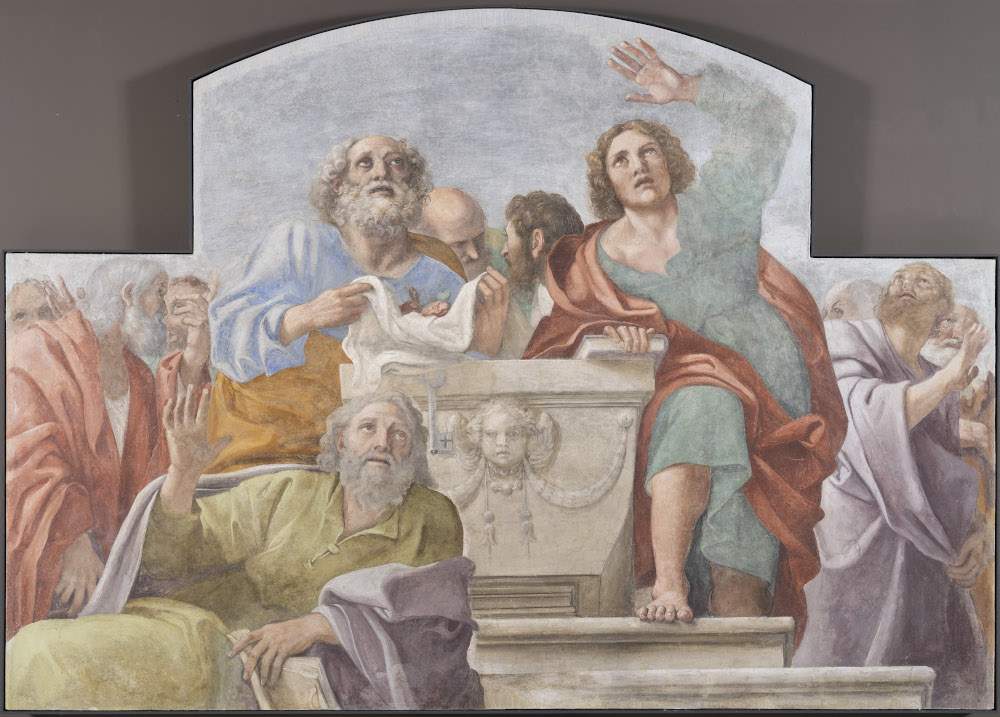From November 17, 2022 to February 5, 2023, the National Galleries of Ancient Art at Palazzo Barberini will host the exhibition Annibale Carracci. The frescoes of the Herrera Chapel, curated by Andrés Úbeda de los Cobos, deputy director of the Prado Museum, and organized with the Museo Nacional del Prado and the Museu Nacional d’Art de Catalunya.
“This exhibition is the result of the joint work of three major international institutions; it will be a unique opportunity to understand what was the Herrera Chapel in St. James of the Spaniards, admired and imitated in the 17th and 18th centuries and destroyed in 1830, as well as, of course, being a’fundamental opportunity for research and studies on Annibale Carracci and his workshop,” commented Flaminia Gennari Santori, director of the National Galleries of Ancient Art.
Following two previous stops at the Prado Museum and the Museu Nacional d’Art de Catalunya, the exhibition will bring together at the Roman museum venue the cycle of frescoes designed by Annibale Carracci for the decoration of the family chapel of Spanish banker Juan Enriquez de Herrera in the Church of San Giacomo degli Spagnoli in Piazza Navona.
Annibale Carracci obtained the commission in the early seventeenth century, devised the entire cycle dedicated to the Franciscan saint Diego of Alcalá and executed some of the frescoes, until in 1605 his serious illness forced him to entrust its execution to Francesco Albani and a small group of other collaborators, including Domenichino, Giovanni Lanfranco and Sisto Badalocchio. Carracci, with the probable intervention of assistants, also painted the altarpiece, now in a chapel in the Church of Santa Maria in Monserrato degli Spagnoli and, on the occasion of the exhibition, exceptionally reunited with the frescoes that surrounded it in the Herrera Chapel.
In the 19th century the chapel was dismantled and in 1830 the frescoes were detached, transferred to canvas and taken to the Church of Santa Maria in Monserrato degli Spagnoli. Shortly thereafter they were sent to Spain and divided between the Prado Museum in Madrid and the Royal Catalan Academy of Fine Arts at Sant Jordi in Barcelona. Currently seven fragments are kept in Madrid, in the Prado Museum, and nine in Barcelona at the Museu Nacional d’Art de Catalunya (MNAC). Of the remaining three fragments of decoration, which were apparently deposited in the Church of Santa Maria in Monserrato degli Spagnoli, their whereabouts are unknown.
The fresco cycle is very significant, although due to dispersion it is little known. The precarious state of conservation of the paintings, particularly those preserved in Madrid, has also made their study and enhancement difficult. The recent restoration has made it possible to address research, deepen studies and identify in this cycle one of the fundamental texts for understanding and defining Hannibal’s late style, as well as the talent of each of his collaborators.
On display in the spaces of the Marble Room, Oval Room and Landscape Room of Palazzo Barberini will be sixteen frescoes, Annibale Caracci’s altarpiece from the Church of Santa Maria in Monserrato degli Spagnoli, a selection of drawings, and a video produced by the Prado Museum illustrating the events related to the genesis of the Herrera Chapel, the authors and iconography, the Church of San Giacomo degli Spagnoli, the dispersion of the paintings and finally their restoration.
A catalog was published on the occasion of the exhibition, edited by Museo Nacional del Prado Difusión for the Spanish and Catalan versions and by Skira Editore for the Italian version.
The volume is also edited by Andrés Úbeda de los Cobos, and contains, in addition to essays by Daniele Benati, professor of modern art history at the University of Bologna, Patrizia Cavazzini, Research Fellow at the British School at Rome and Advisor at theAmerican Academy, Ignacio Fernández, conservator-restorer in charge of the work on the frescoes of the Herrera Chapel in the Prado Museum collection, Paz Marquès, restorer-conservator specialist in mural painting of the Department of Restoration and Preventive Conservation of the Museu Nacional d’ Art de Catalunya, Mireia Mestre, Head of the Department of Restoration and Preventive Conservation of the Museu Nacional d’Art de Catalunya, Ilaria Miarelli Mariani, professor of museology at Università degli Studi Gabriele d’Annunzio in Chieti, Maria Cristina Terzaghi, professor of modern art history at Roma Tre University, Aidan Weston-Lewis, chief curator at the National Galleries of Scotland.
For info: https://www.barberinicorsini.org/
Hours: Tuesday through Sunday from 10 a.m. to 7 p.m.
Image: The Apostles around the empty tomb (fresco transported on canvas, 193 x 272.5 x 3.6 cm; Museo Nacional d’Art de Catalunya. Deposit of the Real Academia de Bellas Artes de Sant Jordi.
 |
| Palazzo Barberini reunites Herrera chapel fresco cycle designed by Annibale Carracci |
Warning: the translation into English of the original Italian article was created using automatic tools. We undertake to review all articles, but we do not guarantee the total absence of inaccuracies in the translation due to the program. You can find the original by clicking on the ITA button. If you find any mistake,please contact us.